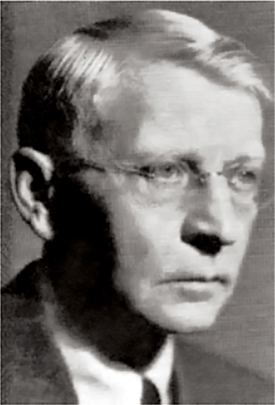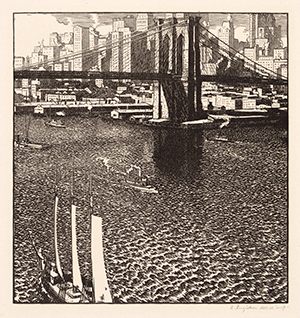
“As well as any man who has ever made a woodcut he has learned how to use the block for the creation of atmoshere. Ruzicka’s gift of charm, a charm heightened by notable self-respect, is seen in all his prints... To his technical competency he has joined a keen sense of the very real poetry of the brick and mortar of New York and Boston... Surely after seeing these no one should lament the limitations of the woodcut or consider it a dying art.”
—William M. Ivins, Jr., The Wood-Engravings of Rudolph Ruzicka, The Newark Museum Association, 1917
Rudolph Ruzicka was born in Kourim, Bohemia, and immigrated to Chicago with his family at the age of ten. He initially pursued his artistic education by taking drawing lessons at the Hull House School before embarking on an apprenticeship in wood engraving. From 1900 to 1902, he enrolled in classes at the Art Institute of Chicago. In 1903, he relocated to New York City, where he began his career as an engraver for the American Bank Note Company and subsequently as a freelance commercial artist. He continued his studies at the Art Students League of New York and the New York School of Art in the following years. In 1906, he returned to the practice of wood engraving, drawing inspiration from the French artist Auguste-Louis Lepere, who adeptly fused European sensibilities with Japanese aesthetics in his compelling engravings of Parisian landscapes.
Ruzicka contributed significantly to the field of typography and illustration, designing typefaces and producing wood engraving illustrations for Daniel Berkeley Updike’s Merrymount Press. He also served as a designer and consultant for the Mergenthaler Linotype Company for fifty years. Throughout his career, he created numerous seals and medals, including those for the American Institute of Graphic Arts (AIGA) and the Dartmouth Medal awarded by the American Library Association.
In 1910, Ruzicka established his shop at 954 Lexington Avenue in New York City, where he received his first major art commission from System magazine. This marked the beginning of numerous exhibitions at prestigious venues, such as the Société de la Gravure in Paris, the Grolier Club, and the Century Association. In collaboration with the Grolier Club, he published "New York," a series of thirty colored wood engravings depicting the evolution of the city's architectural styles.
In 1916, Ruzicka constructed a residence and a workshop in Dobbs Ferry, New York. In 1935, he was awarded the Gold Medal from the American Institute of Graphic Arts. That same year, he joined the Typographic Development staff of the Mergenthaler Linotype Company, where he developed several typeface families. His expertise was further recognized when he was tasked with overseeing a display of antique and modern printmaking processes for the Department of Printing and Graphic Arts at Houghton Library, Harvard University.
In 1948, he relocated to Massachusetts, eventually settling in Vermont. Over the years, Ruzicka collaborated with D. B. Updike on several esteemed book designs, including Newark and the Grolier Club’s Irving, in addition to a notable series of annual keepsakes produced by Merrymount Press. He also provided extensive consulting for Updike’s publication, Printing Types.
Ruzicka's graphic work is represented in the collections of several eminent institutions, including the Brooklyn Institute of Arts and Sciences, Brooklyn Museum, Art Institute of Chicago, Carnegie Institute, Cleveland Museum of Art, Hood Museum, Library of Congress, Metropolitan Museum of Art, National Gallery of Art, Philadelphia Museum of Art, and the Yale University Art Gallery


